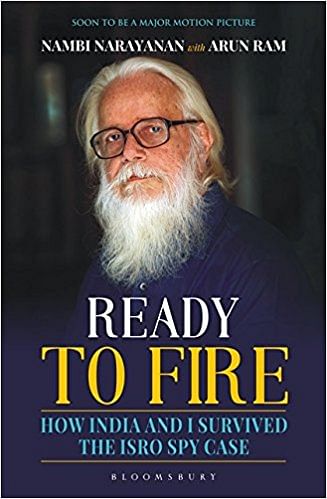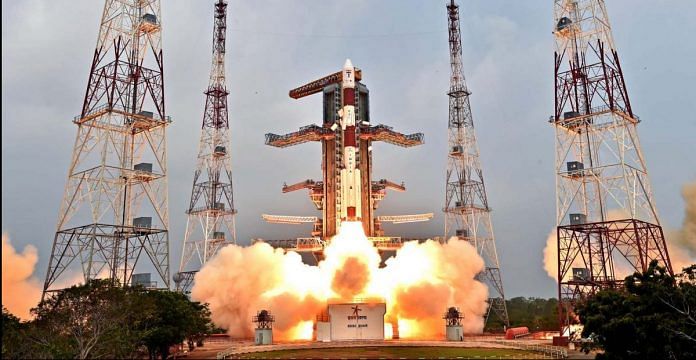Scientist Nambi Narayanan in Ready to Fire: How India and I Survived the ISRO Spy Case writes about being accused of selling top-secret data to foreign nationals and his acquittal.
Nambi Narayanan, the main accused in the 1994 ISRO spy case, juxtaposes the details that the media highlighted with his own straightforward narrative in the book. He was accused of espionage and trying to cripple India’s space programme. Narayanan narrates the development of the Vikas liquid engine around which the case revolved, and the internal politics involving the division heads at ISRO.
Senior journalist Arun Ram has co-written the book with the scientist and gives the book its compelling narrative.
Narayanan calls the ISRO spy case ‘a potboiler of sex, spies and rocket science’. The case that started with a sexual advancement at a Kerala police station became an international conspiracy involving many ISRO scientists. At the peak of the frenzy, Pakistan, North Korea, Sri Lanka, Russia, Germany, Indonesia and Brazil were all part of it. It also implicated key people responsible for constructing nuclear plants in India.
However, as the Central Bureau of Investigation (CBI) began unravelling the case, the conspiracy became obvious. Sadly, it was just collusion between domestic agencies that are meant to safeguard Indian interest, with a foreign agency. Attempts by local media and political parties in Kerala to sensationalise the issue just so that they could get power further accentuated the costs.
The arrests in the case coincided with the developmental flights of PSLV, and India taking possession of cryogenic material from Russia in the 1990s. Although Narayanan does not dwell much on the cryogenic issue, he makes it clear that the transport of material by Ural Airlines to India was not illegal. Despite India’s reasoning, the main aim of the US was to somehow demolish the cryogenic engine transfer. By refuting the claim of illegality, the author simply showcases the conspiracy in the case rather than dealing with technicality.
The first agreement with Russia included the transfer of cryogenic technology and training of scientists which sparked objections from the US. Russia was under intense pressure, and therefore, before it could annul the agreement under force majeure; it was ensured that some of the contract items dealing with technology transfer were accelerated. Narayanan was arrested just before the fourth and final air consignment was to land in India.
The cryogenic engine issue was a clear-cut example of the sole superpower jostling to protect its business interests, an externality India could not influence. However, the story of developing the Vikas engine presents the domestic reality of ISRO’s internal politics inhibiting the space programme.
First, Narayanan portrays ISRO being inconsiderate about the liquid engine development favouring the solid engines. Even when the all-solid engine PSLV simulations failed to meet expectations, the decision-making team did not entertain a solid-liquid engine mix.
Second, the disagreements between key people in-charge of launch vehicles and propulsion had turned hostile.
Third, Narayanan portrays himself as a target for his detractors by narrating the various attempts made to discredit his integrity. On occasions, Narayanan portrays himself as forward-looking, while pointing out the errors of senior ISRO scientists, including former Chairman Satish Dhawan. These claims and allegations could be rather subjective in the absence of counter-claims by particular individuals, and should be taken with a pinch of salt.
These incidents in the course of developing the Vikas engine are narrated parallel to those detailing the interrogation.
Narayanan asserts that it was Sarabhai, the ‘real missile man of India’, who was trying to put together technology from nations vanquished during World War II for India’s space programme, irritating the US in the first place.
The book is a fascinating read, going in-depth into the advent of Vikas engine, particularly a contrast between the friendly attitude of citizens and the experience of being in ISRO. As Narayanan points out, although the Supreme Court has ruled that the case was fabricated, he has vowed to fight for the justice that he deserves.
Vidya Sagar Reddy is a Junior Fellow in the Nuclear and Space Policy Initiative of the Observer Research Foundation, New Delhi.
 Ready To Fire: How India and I Survived the ISRO Spy Case by Nambi Narayanan with Arun Ram has been published by Bloomsbury India.
Ready To Fire: How India and I Survived the ISRO Spy Case by Nambi Narayanan with Arun Ram has been published by Bloomsbury India.






